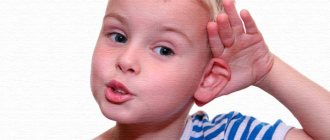: Reading time:
Learning to speak can be uninteresting, unprofitable, or even dangerous. Let's understand the psychological causes of speech development disorders together with psychologist Victoria Melikhova.
If a child does not say his first words between one and a half and three years, this is worth paying attention to. The pediatrician will tell you if you need to take the child to a neurologist and psychiatrist to rule out organic causes. I propose to consider the psychological reasons that prevent a child from developing speech and communication.
When is a child ready to speak?
For the first year, mother and child are in symbiosis. The baby cannot speak; his only language is crying. The mother develops an amazing ability to understand his “language” and translate it into universal human language: now the baby wants to drink, then he wants to eat, and in the evening he wants to sleep. Mom can satisfy his needs. Thanks to this, the child survives the first year.
Gradually, the baby stops latching, begins to crawl, and takes his first steps. This is a very significant event for him. Now he feels separate from his mother. He can move closer or further from her as much as he wants, he can run, he can reach the treasured shelf with a bright toy. It is at this age that the first words appear. As soon as the child begins to feel separate from the mother, the need to talk appears.
On the other hand, by the end of the first year, the mother gradually comes out of fusion with the child and loses her superpower to read minds. Now the child, in order to express himself and his needs, needs to learn to speak his mother’s language.
What should a three year old say?
If a child does not speak at the age of 3, this circumstance alarms even those parents who ignored such a delay at an earlier age.
Normal development of children's speech at 3 years:
- active vocabulary (words used by the baby) ranges from 250 to 1000;
- knows and says how old he is, whether he is a boy or a girl, his first name, last name;
- begins to change, sometimes with errors, words in sentences by gender, case and number;
- sentences pronounced by a three-year-old consist of at least 3 words;
- the child is able to follow multi-step instructions such as “put the car in the closet”, “put the construction set on the table”, “put the books on the bedside table”;
- a large number of adjectives, pronouns, and adverbs appeared in speech;
- understands what “one” and “many” are, they try to count objects;
- some children verbalize what they see or do when they are playing or doing something alone;
- listens with interest to literary works that are understandable to him, looks at pictures in children's books, remembers poems and fairy tales he likes and enjoys telling them to loved ones.
When analyzing your baby’s speech, you need to remember that all children develop along an individual path, and the older they get, the wider the range of skills that distinguishes one child from another. However, when the level of development of a child’s speech differs significantly from the speech of peers, a diagnosis should be carried out with the participation of qualified specialists and understand the reasons for such a lag.
Literature on the topic Koltsova M.M. "The child learns to speak"
Currently, there is a large amount of literature devoted to the problem of developing a child’s speech. One of the most recognized and proven books in this area is Baby Learns to Talk.
This book covers the main stages of speech development, and also gives advice on how to promote its development in a child.
What is speech and how did it originate?
According to the author, speech is what allows people to unite, helps them understand each other, and also helps to form common views and beliefs among people.
For your information! Speech is an integral attribute of cognition of the world, distinguishing man from animals, placing him a step higher in development.
It is believed that the prerequisite for the emergence of speech in human format were those signals (often complex) with which animals exchange information about danger, communicate with each other regarding food, sympathy and watering. In other words, they share experiences and impressions and develop an action plan. This is, in fact, what human speech is intended for.
How does a child understand speech, and what is the role of movements in development?
The child compares the words spoken by others with the events and people around him, with the feelings and impressions that he experienced and learned.
According to research conducted by Fomina, speech is directly related to fine motor skills. This is explained by the fact that the projection of the hand occupies approximately 1/3 of the cerebral cortex. The development of speech directly correlates with the development of motor skills of the hands.
How should you talk to your baby?
The conversation must be structured clearly, correctly and completely pronouncing words. It is required to pay attention to the objects surrounding the child, bring him into dialogue, and stimulate the expression of his needs in verbal form.
How to help your child
When a child at 3 years old does not speak, you should definitely ask how to deal with him, how to teach him to communicate. The necessary recommendations on the formation of a speech environment will definitely be given by specialists - a speech therapist or speech pathologist. Parents can do a lot together with them to stimulate the speech development of a three-year-old child. And, conversely, if there is an indifferent attitude towards the child’s capabilities and achievements, professionals will be less able to help.
Tips for stimulating children's speech:
- Accompany with your comments all actions related to joint activities with your baby, explain the functions of individual objects, talk about what interesting things you saw on a walk, from the window of a bus or car during a trip. You may not receive a response from the child yet, but his passive vocabulary will be steadily expanding.
- Make sure that your speech is a standard, has a clear sound and correct pronunciation.
- Read children's literature, encourage them to repeat phrases and lines from poems, look at illustrations, explaining what is depicted on them.
- Do not leave your child alone with the TV or tablet; watch cartoons and play games together, explaining the names of the characters and the actions of the characters.
- Teach your child to assemble a mosaic, string beads on a cord, make buildings from cubes, place cereals, peas, and beans on plates, because the development of fine motor skills actively stimulates the speech areas of the brain.
- Learn a few finger games or nursery rhymes and play them more often; this activity also develops speech and fine motor skills.
Try not to rush to the child’s aid, fulfilling his silent requests. Let him try to express his desire. Sometimes being in a children's group, in joint developmental classes, becomes a powerful impetus for overcoming speech delays. If he wants to communicate, the baby will try to use all the resources he has.
Attentive attention to the problems of speech delay in a three-year-old child, timely diagnosis, and timely start of classes with specialists will reduce the time for the necessary correction and prevent further lags behind peers.
Diagnosis of bradyllalia
Parents of a child who speaks slowly should seek professional help. A comprehensive examination may require the participation of a neurologist, psychiatrist, speech therapist and psychologist. Instrumental studies are used to identify the physiological causes of speech pathology. The child may be prescribed:
- MRI of the brain;
- PAT;
- rheoencephalography;
- EEG, etc.
In addition, the child is examined by a speech therapist. He conducts speech diagnostics to determine the degree of bradyllalia and select an effective correction method.
How does auditory speech agnosia differ from sensory alalia?
I’ll tell you a little about the development of speech understanding in ontogenesis. At the age of up to 1 year, priority development occurs in the temporal region of the right hemisphere. That is, the child first of all matures the ability to holistically perceive non-speech (objective) noises (loudness, tonality, source, melody, rhythm, intonation). Non-speech noises also include sounds made by animals. This is the foundation for subsequent understanding of speech, which is why it is so important for children to provide a varied sound environment. As a result, the child develops his first onomatopoeias. In correction, speech therapists also use techniques to distinguish between various object noises to pass this stage of development (if it has been disrupted) and the subsequent formation of speech auditory gnosis.
At the age of about 1-1.2 years, the secondary fields of the temporal cortex of the left hemisphere are activated (they mature completely by 2 years). And in the noise stream the child begins to isolate speech sounds. His onomatopoeias acquire a “human” pronunciation, vocalizations, normative echolalia (repetitions of heard words), and interjections (oh, bang, bam) begin. This is not one sound, but a series of sounds and simple words that can already be used in a familiar context (mom, dad, baba). This is the stage of maturation of speech auditory gnosis. The child does not yet have the ability to understand the polysemy of words; context (necessarily substantive) is important. Immaturity of the secondary fields of the temporal cortex results in speech auditory agnosia . And if this stage has not been passed, then further development of speech understanding does not occur.
Next, the tertiary fields of the cortex mature - this is the zone where the “overlap” of the parietal, temporal and occipital cortices occurs. The so-called TPO zone. Or the posterior association cortex. And the words perceived by the secondary cortex begin to be saturated with different meanings, connected with each other, acquiring semantic shades and developing without a strict connection to one object. The child begins to master his native language. Among biological species, only humans have tertiary fields. Violation at this stage leads to sensory alalia.
The main practical problem is that the immaturity of the previous level of the auditory analyzer leads to underdevelopment of the next one. Sometimes it is impossible to clearly differentiate whether the formation of only secondary or tertiary fields at the stage is disrupted. And as hardware diagnostics using the evoked potential method shows, impulse conduction is often disrupted in children, not reaching the cortex at all! That is, in essence, they have mild sensorineural hearing loss, which was not identified in a timely manner. And if the impulse to the cortex comes with a delay and in incomplete volume, then the primary, secondary, and tertiary cortex suffer. Language acquisition and thinking are impaired.
Signs of speech delay
The reason for parental wariness should not only be the child’s mistakes in coordinating and changing words and in pronunciating sounds. At this age, speech is the main means of communication between children and loved ones. If the baby does not strive to turn to parents and other family members, if he expresses his requests with facial expressions or gestures, it is worth carefully assessing his speech capabilities.
Signals of trouble if a 3-year-old child speaks poorly:
- it has a limited vocabulary, consisting mainly of nouns, less often verbs, onomatopoeia, and babbling words.
- his conversations are like the speech of a foreigner whom few can understand.
- When pronouncing sounds, a large number of substitutions and distortions of sounds are observed. For example, instead of the sound [k], the sound [t] speaks (cat - that), when he speaks, his tongue is between his teeth;
- the baby speaks in phrases consisting of 1–2 words, is very reluctant to repeat words or sentences after adults, or does not do this at all.
- cannot fulfill a simple request, does not respond to his name, does not know how old he is;
If the cause of a child’s speech delay is hearing problems, the baby may not respond to words addressed to him until he sees the speaker’s face. In case of auditory pathology, it is necessary to begin hearing correction as soon as possible in order to make up for lost time for the formation of children's speech. With properly organized training, the speech of such children after a year and a half is almost no different from the speech of their peers.
When a child is silent or speaks poorly at three years old, this may be a symptom of various disorders. First, you should contact an otolaryngologist and neurologist for examination, and get advice from a speech therapist, speech pathologist, or psychologist. If a child does not speak for 3 years, this is not laziness or lack of upbringing. He may have the following speech development problems:
- motor or sensory alalia;
- speech tempo delay;
- general speech underdevelopment (GSD).
Each of these pathologies, despite the fact that it manifests itself with similar symptoms, requires a different corrective approach. A timely identified problem will allow you to select an individual lesson plan with a speech therapist, psychologist, or speech pathologist.
The reasons for underdevelopment of children's speech may be the following:
- chromosomal pathologies, congenital diseases;
- heredity, when in one family several generations have a late onset of speech;
- pathologies of pregnancy and childbirth;
- pedagogical neglect - happens not only in asocial families where they do not pay attention to children, but also where they love him madly and try to fulfill all his whims and desires;
- diseases and injuries of the brain at an early age.
The most severe consequences are caused by brain damage during fetal development, during childbirth and in the first year of life.
Speech disorders
Pathologies of the nervous system leading to speech underdevelopment: dysarthria, aphasia, motor and sensory alalia.
Dysarthria
Dysarthria is a speech disorder that can be caused by various diseases of the nervous system. It is characterized by insufficient mobility of the baby’s speech organs and, as a result, underdeveloped speech and difficulty learning to read and write.
Causes of dysarthria:
- Mother's illness
- Birth injury
- Fetal hypoxia
- Premature birth
- Trauma, brain tumors
Characteristic features of the pathology:
- The child speaks very poorly.
- The baby's breathing rhythm is disturbed.
- Nasal voice.
- Weak tone of the facial muscles.
- Trembling tongue and profuse salivation.
- Large and fine motor skills are impaired. The toddler cannot jump, stand on one leg, and has poor balance.
Aphasia
Aphasia is a disorder in which at three years of age the child may not speak at all, or if the child spoke before and a friend abruptly fell silent.
Causes of aphasia:
- Traumatic brain injuries
- Inflammatory processes in the brain
- Central nervous system diseases
- Vascular diseases
Motor alalia
Motor alalia is a speech disorder in which a child may confuse the endings of words, gender inflections, and in severe forms may not speak at all.
Causes of motor alalia:
- Birth injuries
- Damage to areas of the cerebral cortex that are responsible for speech development
- Intrauterine infections.
Characteristic features of the pathology:
- The baby understands everything that adults tell him, but he himself does not speak.
- The baby does not control his tongue and lips.
- Hyperactive or, conversely, inactive, clumsy.
- Does not make contact with adults.
Sensory alalia
Sensory alalia is a speech disorder in which the child does not understand speech addressed to him or understands only individual words. He cannot understand the essence of the entire sentence.
Characteristic features of the pathology:
- Low intelligence.
- Senseless, incoherent pronunciation of sounds and individual words.
- Saying multiple words in one word.
Why doesn't he speak?
In fact, “does not speak” is a rather loose concept. Let's give examples.
- The child does not utter any words at all, not even “yes” and “no.” For a 1.5 year old this is normal, but for a 4 year old child this is already a problem.
- Doesn't speak sentences. For 2.5 years it will be the norm. At 4 years old you already need to worry.
- The child understands spoken speech, fulfills requests and instructions, regardless of complexity, but does not speak.
- The child talks a lot, but in “his” language.
- The child speaks, but those around him do not understand him, because he replaces many sounds.
That is, in each situation the concept of “does not speak” will be different. And here it is important to understand the reason, find an approach and correct it. In some cases, it is possible to involve more specialized specialists.
It is important to understand that in the process of speech formation, understanding it is more important than pronunciation.
Who needs examinations?
Examinations are needed if the doctor suspects a child has speech development delay (SDD). Not all children who do not speak have this delay and not all children need testing.
If RRR is still suspected, then the following examinations are necessary.
- Examination by a pediatrician.
- Examination by a neurologist.
- Examination by a psychiatrist (included in the medical examination of children 2 years old).
Research carried out according to indications.
- Electroencephalogram (EEG and sleep monitoring. In very rare cases, a child experiences developmental regression and this is associated with a large amount of epiactivity on the EEG during sleep, when the child does not have epileptic seizures.
- MRI.
- Genetic tests.
- Examination by an audiologist, audiometry,
- Acoustic Spectrum Disorder Test.
Tahilalia
With tachylalia, a pathological acceleration of the tempo is observed, while the child has normal hearing and no pathologies of the speech organs. Speech is fast, incomprehensible, the baby often swallows endings, distorts and repeats words, articulation is changed. Tachylalia is often associated with neurological disorders and can be manifested not only by an accelerated rate of speech, namely:
- the child stammers, swallows words;
- he doesn't have enough air to say the next words;
- moves fussily and quickly;
- has trouble falling asleep, often wakes up;
- there are problems with memory, reading, writing;
- often gets irritated and behaves aggressively;
- has difficulty concentrating on a task;
- attention is scattered.
Children with tachylalia talk non-stop, they do not listen and interrupt their interlocutor, and therefore they have problems communicating with peers and adults.
In some cases, tachylalia is caused by a hereditary predisposition, but often this disorder is explained by damage to the central nervous system due to severe infections, injuries, and certain diseases.
Diagnosis and treatment of tachylalia occurs with the participation of a speech therapist, neurologist and psychologist. If time is not lost, then the overall prognosis is favorable. Tachylalia may return within a year after correction. The most lasting results are provided by group classes with an experienced speech therapist.








